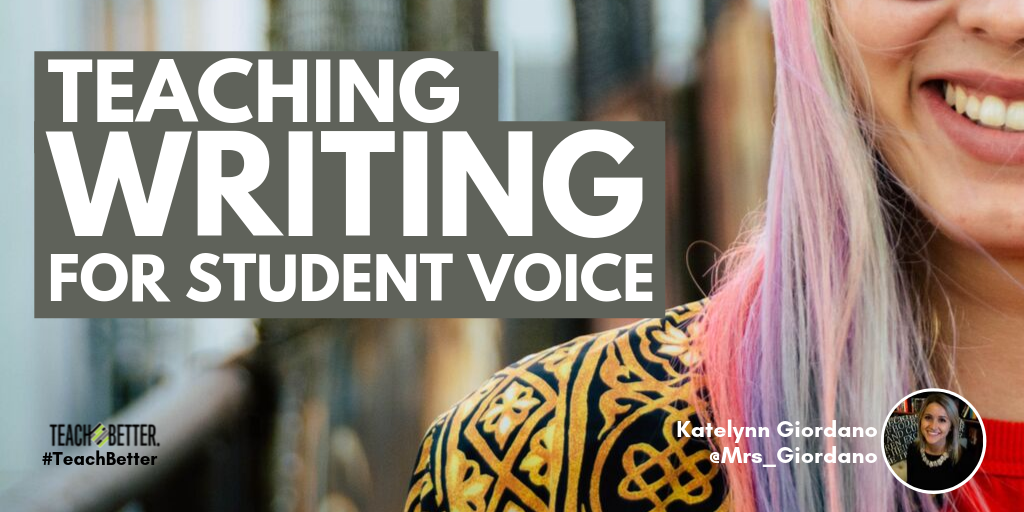In this post:
- The importance of providing freedom for students in your writing instruction.
- Strategies to use when teaching writing to shift the focus to student voice.
- My experience and background in empowering student writers.
When we think about teaching writing, we often associate it with the traditional 5 paragraph essay, a regimented guide, or a ready-made curriculum. There’s a prescribed method to follow, a formulaic approach taught, and a standard response from each student. Often, topics are pre-selected, complete with research articles, graphic organizers, and a general idea of ‘what our kids will want to write about’.
I’m here to tell you—this approach doesn’t work.
It will teach a standard 5 paragraph essay, but it will also restrict your students. For many, it will likely turn them off to writing. When students are handed pre-formatted, boxed in responses, we remove a massive part of the writing process. We take away one of the most crucial components to a well written, engaging piece.
Their voices.
When students are handed pre-formatted, boxed in responses, we remove a massive part of the writing process - their voices. Click To TweetWriting is an extension of our voices. It is a mode of expression, a way of communicating, and it creates a relationship between writer and reader. That’s why we connect emotionally to books, especially those that are crafted beautifully. It’s why words can be so powerful and influential, and why the phrase “the pen is mightier than the sword” even exists.
To teach writing in this way, it’s important to acknowledge the fact that students will take over a lot of the control. It’s just as important to realize that there will still need to be structure and guidance, but it’s going to look a little (or a lot) different.
For me, making this shift has been incremental. I’ve taken small steps over time to develop a writing curriculum that builds student voice and choice within the medium. I’m going to share some of that process, and hopefully give a few ideas for how to start making that shift.
Incorporate choices in topic
When it comes to teaching writing for voice, the biggest shift to make is including choice for students. They are not going to have a voice if their topics are chosen for them. They need to feel a connection to what they are writing about. It’s got to be relevant to them. Even better if it incorporates their passion and their experience.
Really any choice is beneficial. Even a moderated one, like providing a menu for kids to choose from. That, though, can be limiting. What I’ve found most successful is to have an overall theme, provide some examples (which can be chosen as topics by our kiddos who need more guidance), and allow students to choose on their own from there.
For example, my argumentative/opinion piece is based on the theme of heroism. We look at controversial historical figures, those that are typically considered heroes, and discuss as a class how they have been portrayed. We consider figures like Christopher Columbus, and discuss how history can be biased or skewed.
Students then choose their own historical figure to research and ultimately argue whether they fit the definition of a hero. There’s a lot of discussion and debate, about biases in history and present day. I end up reading some truly interesting pieces. And I’ve got to tell you, it certainly beats reading 92 of the same exact essay that all argue the same exact points.
Provide ample time to write
Part of helping our students find their writing voice is giving them time to actually write. This should be uninterrupted time devoted to them exploring the craft, working through the process, and just getting into the flow of a piece. Finding their groove will take time, and we have to give it to them.
Some students might work at different paces. Allow this to happen as much as you possibly can. If a student is flying through, find ways to provide additional avenues. If they require a slower pace, give them that room. Ideally, you want students working in a way that suits them, discovering their processes as they go. And if a student wants to go back and revise a piece after the due date, please let them.
[scroll down to keep reading]

Get rid of graphic organizers
This might be an unpopular one. While there are benefits to providing a guide for an evidence-based paragraph, they should not become the backbone of our writing curriculum, nor should they be a crutch our students must use every time they write.
Graphic organizers don’t teach students how to logically organize a piece. They show students that rather than looking at the words, reading them for their message and clarity, that they just need to “plug in” the sections to formulate a good response. These organizers remove voice almost entirely, giving students a singular option for expressing a thought or idea.
Organization must be taught, absolutely. But instructing our students to put in the pieces and spit out the finished product just isn’t going to do it.
Use conferences
Students will need guidance throughout writing a piece. Naturally, we will have to teach foundational writing skills and offer assistance along the way.
Because our students will be creating unique pieces, our instruction should be targeted to what they need. I use conferences, sometimes one on one but mostly small group, to hone in on the skills that require development. A workshop model tends to work best for me, where I start with an overall mini lesson for the class and then meet with smaller groups or individuals to go more in depth based on their needs.
Conferences also provide a place for students to ask their own questions as they find areas or skills they want to learn. Often, students will bring their own ideas to a conference, looking for feedback or guidance from me on how best to make their ideas a reality. I always love when that happens because they’re really beginning to see themselves as writers.
Writing is an amazing medium. It’s an expression of voice, a crafting of ideas into words. Not much else yields such power, such influence. Let’s teach our students to wield their pens and express their thoughts, not just follow a formula.
About Katelynn Giordano
Katelynn Giordano is a 6th grade language arts teacher in the Chicago suburbs and the Digital Content Editor for the Teach Better Team. She loves writing, both on her blog, Curriculum Coffee, and for the Teachers on Fire magazine on Medium. She is a dynamic educator with a focus on student empowerment in the ELA classroom. Her writing and presentations are all about incorporating student voice, choice, and personalized learning in your teaching practice.
Katelynn is active on Twitter and Instagram, and loves to collaborate with educators everywhere! In her free time, she enjoys relaxing with her husband and her cat, Chickpea, drinking coffee, and reading YA books.



